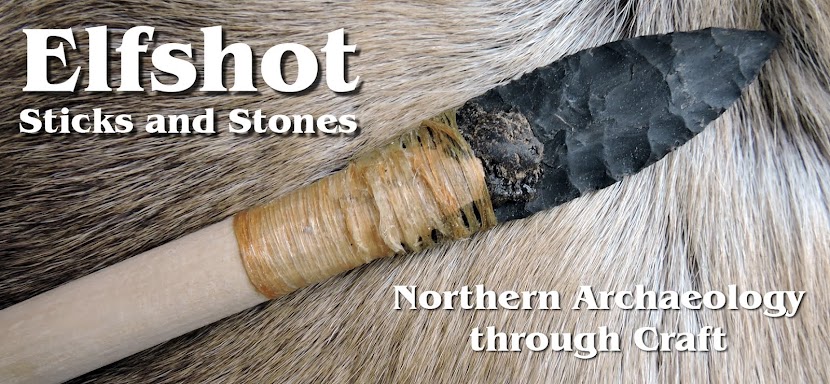The Dorset knives are a favourite of mine. I talked about them in a previous post and explained why I think the knife handle is a stylized polar bear. Here's a photo I took years ago of the actual artifact and a typical dorset chert knife blade (the scale is 10cm).
 The handle wasn't found with a blade, but these triangular stone knives are fairly common artifacts in Newfoundland. It looks like the one in the photo has had some resharpening retouch done along the top and bottom blade edges, it probably would have started out a little bit wider in the middle. The handle was found at Port au Choix, on Newfoundland's northern peninsula and is now on display at The Rooms in St. John's.
The handle wasn't found with a blade, but these triangular stone knives are fairly common artifacts in Newfoundland. It looks like the one in the photo has had some resharpening retouch done along the top and bottom blade edges, it probably would have started out a little bit wider in the middle. The handle was found at Port au Choix, on Newfoundland's northern peninsula and is now on display at The Rooms in St. John's.When I make these knives I alway start with the knapped blade and then create an antler handle that would balance it. I'll scale the artifact handle up or down to create a match. In reality, the handle would have probably been re-used and curated many times as the stone blades broke or wore out. (The knife I made this week is to replace one that was bought on a trip to Newfoundland several years ago, but broke in a horrible dusting accident.) Using a stone tool kit, the labour in the antler handle would far outweigh the labour in making a stone blade to match. A broken stone blade could be reworked into another tool or discarded, but the handle would be held on to and reused. Which, along with poor preservation of organic tools in most of the Province, is one of the reasons why archaeologists have found hundreds of the stone blades and only 2 of the handles.
The handle has a slot in it and an incised groove for a lashing material. I use hide glue to secure the blade to the handle and tie it on with sinew. Its important the the grooves on the handle are deep enough that the sinew makes contact with the stone inside the notches. If I tea stain the handle to antique the antler I do it before attaching the blade. The hide glue and sinew is water soluble, so it would just unravel if it was dunked in warm tea. Using a reversable glue like this in the past would have been important when it came time to retool the handle.
Photo Credits: Tim Rast
Photo Captions:
Top; Dorset Palaeoeskimo knife reproductions, antler, chert, sinew and hide glue
Middle, Photo of original artifact from Port au Choix, Newfoundland and Labrador
Bottom, In progress shot of the reproduction knives in the top photo



Great post. I think I might need to hear more about this 'terrible dusting accident', in a future post! :) Hope you are both having a nice long weekend.
ReplyDeleteHey Brenda -- Thanks for taking the time to comment! Unfortunately I don't have a lot more information on the dusting accident, but one of the properties of stone that makes it good for knapping is being brittle. That's good for cracking off flakes, but bad if the stone tool falls from a shelf and hits a hard surface.
ReplyDeleteThat's one of the big advantages that metal tools had over stone; metal might not give as sharp a cutting edge, but it is much more durable and less prone to accidental breaks.
There was an interesting experiment done where chimps demonstrate how effective hard surfaces are for fracturing stone. Fruit treats were hidden in boxes that were tied up with twine. The chimps were shown how to use a hammerstone to crack a flint core and use the sharp flakes to cut the twine. The chimps learned that flakes were sharp, but the hammerstone thing didn't impress them - they just threw the flint at the ground until a flake came off. Then they used the sharp edge to cut the twine. That's probably a good analog for how the very earliest stone tools were made.
I love your stance, a stone carver whose business dried up thousand's of years ago and still working, it may come back, we'll need you then......
ReplyDelete